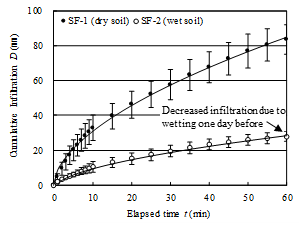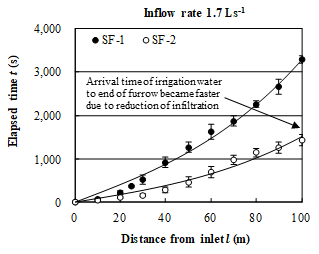Simplified surge flow with improved furrow irrigation reduces infiltration loss and saves water
Description
In arid lands, the groundwater table on irrigated farmlands has been rising due to the large amount of infiltration caused by excessive irrigation. As a result, salts become accumulated in the root zone, reducing agricultural production. In the Republic of Uzbekistan where large-scale irrigation development was carried out during the Soviet era, about 51% of irrigated farmlands are salt-affected, and it has become a serious problem. Water-saving methods such as the drip and sprinkler system are generally effective in controlling the groundwater table, but these were not adopted widely due to lack of facilities and funds. Hence, furrow irrigation with large infiltration loss was conducted in Uzbekistan’s vast farmlands. Surge flow irrigation (SF) was applied in furrows to save water and reduce infiltration loss by supplying water intermittently. However, it required some investments such as water supply pipes and switching valves, thus leading to the development of the simplified SF irrigation method.
Whereas conventional furrow irrigation is done once and SF around 4 times, simplified SF is done two times at 1-day intervals. When irrigating a 100-m furrow by Simplified SF, irrigation is carried out by supplying water from 0 m to 50 m (stopped upon reaching 50m) (1st irrigation, SF-1). One day later, water is supplied from 0 m to 100 m (2nd irrigation, SF-2) (Fig. 1). By wetting one day before, water infiltration at the wet furrow (SF-2 condition) became slower than at the dry furrow (SF-1 condition), and the cumulative infiltration after 60 minutes decreased by 67% compared with the dry furrow (Fig. 2). Moreover, at an inflow rate to furrow of 1.7 Ls-1, water advanced faster during 2nd irrigation due to the decrease in infiltration following the 1st irrigation. As a result, the arrival time to the furrow end and total irrigation time became shorter (Fig. 3) compared with conventional irrigation. In the case of irrigating the 100-m furrow at a 1.7 Ls-1 inflow rate, simplified SF saved water by 19% compared with conventional irrigation. Further, when furrow length was shortened to 50 m, the water-saving effect increased to 22%. In the case of irrigating the 100-m furrow at a 5 Ls-1 inflow rate, even conventional irrigation could reach the furrow end in a short time as there is no reduction in the water-advance speed; apparently, under this scenario, simplified SF (i.e., irrigation done two times) does not conserve water.
Simplified SF would be most applicable as a surface irrigation method in farmlands with highly permeable soils. When applying simplified SF, farmers should consider the furrow length, the inflow rate, and the water-advance speed in the furrow. Inflow rates and water-advance speeds are affected by the slope and unevenness of the farmland; thus, to generate enough water-saving by simplified SF, land leveling at 1/500 to 1/1000 slopes and making precise furrows are necessary. In Uzbekistan, water-saving efforts by farmers are lacking because water fees are collected based on farmland area. Nevertheless, simplified SF can help control water table rise, thereby reducing salt accumulation, saving water, and extending the cultivation area.
Figure, table
-
Fig. 1. Comparison between simplified SF and conventional furrow irrigation
-
Fig. 2. Infiltration of water into the dry/wet furrow
-
Fig. 3. Arrival times of irrigation water to each point along the furrow
-
*) Ratio of water-saving amount by Simplified SF to amount of supplied water by conventional over the same length of the furrowTable 1. Water-saving effect and application efficiency of the Simplified Surge Flow method Inflow Length Required water [RW] Treatment Time(sec) Supplied water
[SW]Water-saving ratio*) Application efficiency
[RW/SW](Ls-1) (m) (m3) Ave Std (m3) (%) (%) 1.70 100 2.45 Conventional 3,289 88.2 5.59 0.15 - 43.8 100 2.45 Simplified SF 2,667 229.3 4.53 0.39 19.0 54.1 50 1.22 Conventional 1,299 152.6 2.21 0.26 - 55.2 50 1.22 Simplified SF 1,014 57.5 1.72 0.10 22.2 70.9 5.00 100 2.45 Conventional 1,148 95.7 5.74 0.48 - 42.7 100 2.45 Simplified SF 1,392 99.0 6.96 0.50 -21.3 35.2
- Affiliation
-
Japan International Research Center for Agricultural Sciences Rural Development Division
- Research project
- Program name
- Term of research
-
FY2018 (FY2013-FY2020)
- Responsible researcher
-
Onishi Junya ( Rural Development Division )
Ikeura Hiroshi ( Rural Development Division )
Paluashova G ( Research Institute of Irrigation and Water Problems )
Shirokova Y. L. ( Research Institute of Irrigation and Water Problems )
Yamanaka Isamu ( NTC International Corporation )
Kitamura Yoshinobu ( Tottori University, International Platform for Dryland Research and Education )
KAKEN Researcher No.: 80284008Fujimaki Haruyuki ( Arid Land Research Center, Tottori University )
KAKEN Researcher No.: 90323253 - ほか
- Publication, etc.
-
https://doi.org/10.14976/jals.27.3_91
Onishi J. et al. (2017) Journal of Arid Land Studies 27(3):91-101
Onishi J et al. (2019) Paddy and Water Environment, 17(2): (In press)
- Japanese PDF
-
A4342.67 KB
A3271.6 KB
- English PDF
-
A4217.6 KB
A3246.85 KB
- Poster PDF
-
2018_A06_poster.pdf271.05 KB



